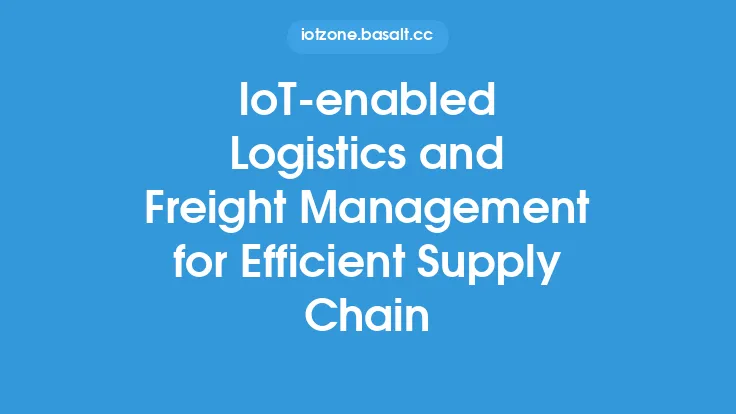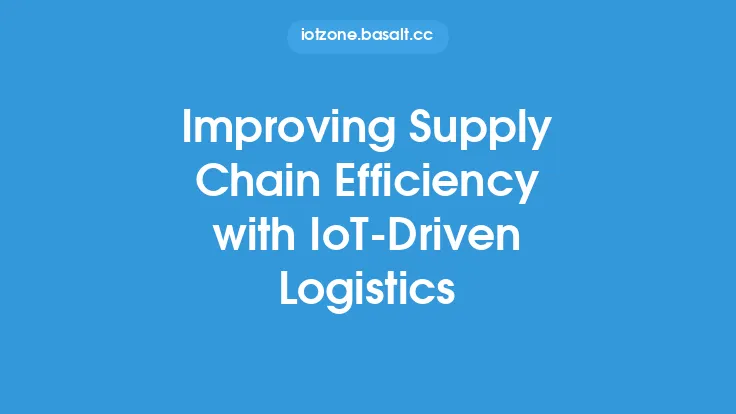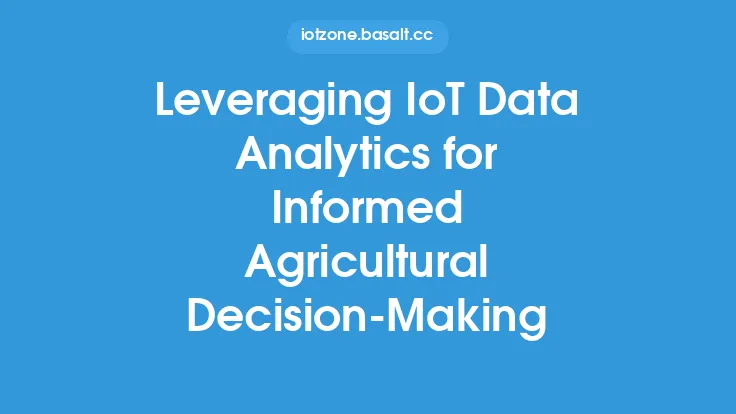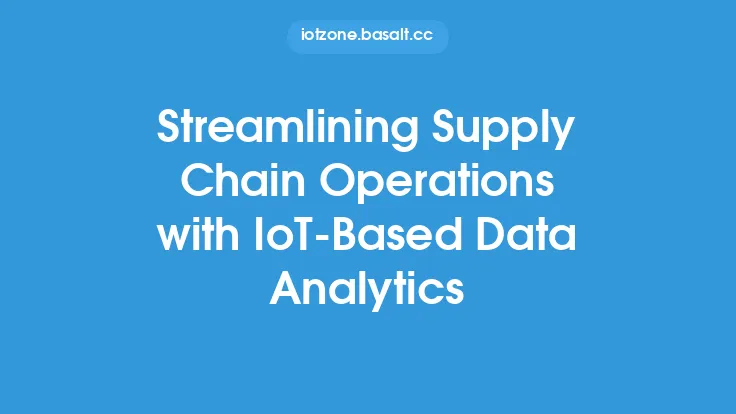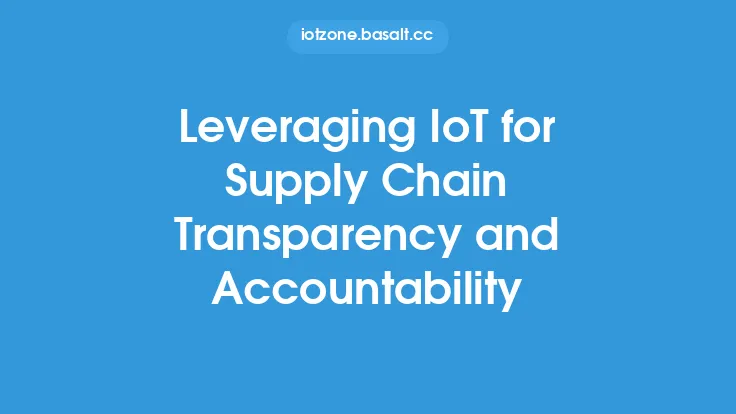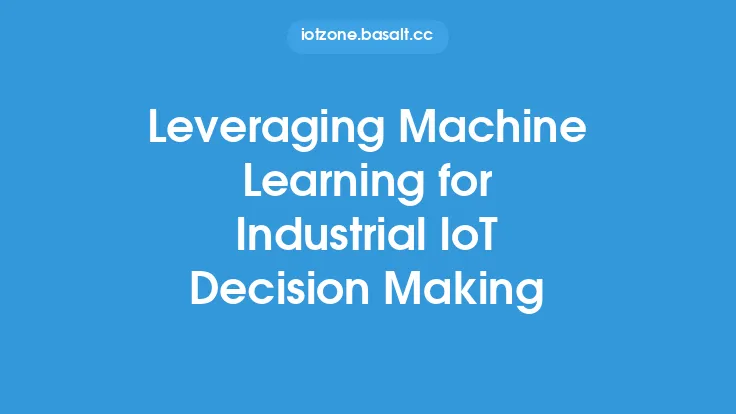The Internet of Things (IoT) has been transforming various industries, and the retail and supply chain sector is no exception. One of the key benefits of IoT in this sector is the ability to provide real-time visibility into the supply chain, enabling better decision making. This is achieved through the use of IoT devices such as sensors, GPS trackers, and RFID tags, which can be attached to products, pallets, or containers to track their movement and condition in real-time.
Introduction to IoT-Enabled Supply Chain Visibility
IoT-enabled supply chain visibility refers to the ability to track and monitor the movement of goods, products, and assets in real-time, from the point of origin to the point of delivery. This is made possible through the use of IoT devices and sensors that can transmit data to a central platform, providing stakeholders with real-time insights into the supply chain. This visibility can help organizations to identify bottlenecks, optimize logistics, and improve overall supply chain efficiency.
Benefits of IoT-Enabled Supply Chain Visibility
The benefits of IoT-enabled supply chain visibility are numerous. Some of the key advantages include:
- Improved supply chain efficiency: With real-time visibility into the supply chain, organizations can identify bottlenecks and optimize logistics to reduce delays and improve delivery times.
- Enhanced inventory management: IoT-enabled supply chain visibility can help organizations to track inventory levels in real-time, reducing the risk of stockouts and overstocking.
- Better decision making: With access to real-time data, organizations can make informed decisions about supply chain operations, such as routing, scheduling, and resource allocation.
- Increased transparency: IoT-enabled supply chain visibility can provide stakeholders with real-time updates on the status of shipments, improving transparency and reducing the risk of disputes.
Key Technologies Used in IoT-Enabled Supply Chain Visibility
Several key technologies are used in IoT-enabled supply chain visibility, including:
- GPS tracking: GPS trackers can be attached to vehicles, containers, or pallets to track their movement in real-time.
- RFID tags: RFID tags can be attached to products or containers to track their movement and condition.
- Sensors: Sensors can be used to track temperature, humidity, and other environmental conditions that may affect the quality of goods in transit.
- Cellular networks: Cellular networks such as 2G, 3G, and 4G can be used to transmit data from IoT devices to a central platform.
- Cloud computing: Cloud computing platforms can be used to store and analyze data from IoT devices, providing stakeholders with real-time insights into the supply chain.
Implementation of IoT-Enabled Supply Chain Visibility
Implementing IoT-enabled supply chain visibility requires a thorough understanding of the supply chain and the technologies used. Some of the key steps involved in implementation include:
- Identifying the scope of the project: Organizations need to identify the specific areas of the supply chain where they want to implement IoT-enabled visibility.
- Selecting the right technologies: Organizations need to select the right technologies, such as GPS trackers, RFID tags, and sensors, to achieve their goals.
- Integrating with existing systems: Organizations need to integrate IoT-enabled supply chain visibility with existing systems, such as enterprise resource planning (ERP) and transportation management systems (TMS).
- Analyzing and interpreting data: Organizations need to analyze and interpret data from IoT devices to gain insights into the supply chain and make informed decisions.
Challenges and Limitations of IoT-Enabled Supply Chain Visibility
While IoT-enabled supply chain visibility offers numerous benefits, there are also several challenges and limitations to consider. Some of the key challenges include:
- Cost: Implementing IoT-enabled supply chain visibility can be expensive, particularly for small and medium-sized enterprises.
- Complexity: IoT-enabled supply chain visibility requires a thorough understanding of the supply chain and the technologies used, which can be complex and time-consuming to implement.
- Security: IoT devices can be vulnerable to cyber threats, which can compromise the security of the supply chain.
- Data overload: IoT devices can generate vast amounts of data, which can be overwhelming to analyze and interpret.
Best Practices for Implementing IoT-Enabled Supply Chain Visibility
To overcome the challenges and limitations of IoT-enabled supply chain visibility, organizations should follow best practices such as:
- Starting small: Organizations should start with a small pilot project to test the technologies and processes before scaling up.
- Focusing on key performance indicators (KPIs): Organizations should focus on key performance indicators, such as delivery times and inventory levels, to measure the effectiveness of IoT-enabled supply chain visibility.
- Collaborating with stakeholders: Organizations should collaborate with stakeholders, such as suppliers and logistics providers, to ensure that everyone is aligned and working towards the same goals.
- Continuously monitoring and evaluating: Organizations should continuously monitor and evaluate the effectiveness of IoT-enabled supply chain visibility and make adjustments as needed.
Future of IoT-Enabled Supply Chain Visibility
The future of IoT-enabled supply chain visibility is exciting and rapidly evolving. Some of the key trends to watch include:
- Increased use of artificial intelligence (AI) and machine learning (ML) to analyze and interpret data from IoT devices.
- Greater use of blockchain technology to improve the security and transparency of the supply chain.
- Increased adoption of IoT-enabled supply chain visibility in industries such as healthcare and pharmaceuticals, where the tracking and monitoring of goods is critical.
- Greater focus on sustainability and environmental responsibility, with IoT-enabled supply chain visibility helping organizations to reduce their carbon footprint and improve their environmental performance.
